|
Endoscopic image of a colon affected by ulcerative colitis. The internal surface of the colon is blo ...
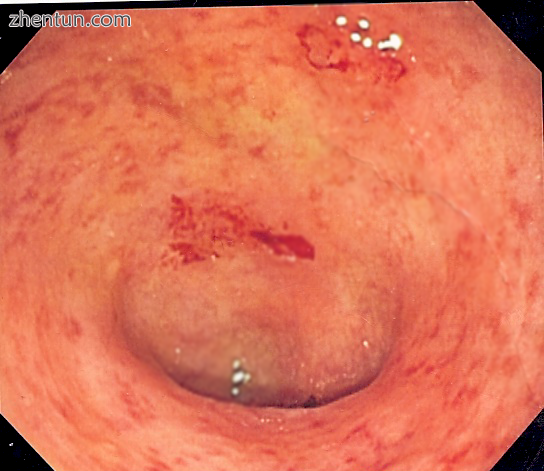
受溃疡性结肠炎影响的结肠的内窥镜图像。结肠的内表面有斑点并且在某些地方破裂。
溃疡性结肠炎(UC)是一种长期病症,会导致结肠和直肠的炎症和溃疡。[1] [6]活动性疾病的主要症状是腹痛和腹泻与血液混合。[1]也可能发生体重减轻,发烧和贫血。[1]通常症状缓慢发作,范围从轻微到严重。[1]症状通常间歇性地发生,并且在耀斑之间没有任何症状。[1]并发症可能包括巨结肠,眼部炎症,关节或肝脏,以及结肠癌。[1] [2]
UC的原因尚不清楚。[1]理论涉及免疫系统功能障碍,遗传,正常肠道细菌的变化和环境因素。[1] [7]发达国家的比率往往较高,有些人认为这是由于较少接触肠道感染,或西方饮食和生活方式。[6] [8]早期移除阑尾可能具有保护作用。[8]诊断通常通过组织活检进行结肠镜检查。[1]它是一种炎症性肠病(IBD)以及克罗恩病和显微镜结肠炎。[1]
饮食变化,如保持高热量饮食或无乳糖饮食,可能会改善症状。[1]几种药物用于治疗症状并带来和维持缓解,包括氨基水杨酸盐​​如美沙拉嗪或柳氮磺胺吡啶,类固醇,免疫抑制剂如硫唑嘌呤和生物治疗。[1]如果疾病严重,对治疗没有反应,或者结肠癌等并发症发生,可能需要通过手术切除结肠。[1]去除结肠和直肠可以治愈疾病。[1] [8]
加上克罗恩病,截至2015年,约有1,120万人受到影响。[9]每年新发生的人数为每10万人1至20人,每10万人中有5至500人受到影响。[6] [8]这种疾病在北美和欧洲比其他地区更常见。[8]通常它始于15至30岁的人或60岁以上的人。[1]男性和女性似乎受到相同比例的影响。[6]自20世纪50年代以来,它也变得越来越普遍。[6] [8]溃疡性结肠炎和克罗恩病共同影响了美国大约一百万人。[10]通过适当的治疗,死亡风险与普通人群相同。[2]溃疡性结肠炎的第一次描述发生在19世纪50年代左右。[8]
视频: ↓ 什么是溃疡性结肠炎
https://cache.tv.qq.com/qqplayerout.swf?vid=a0755088nu1
内容
1 症状和体征
1.1 胃肠道
1.2 肠外功能
2 原因
2.1 遗传因素
2.2 环境因素
2.3 自身免疫性疾病
2.4 替代理论
3 病理生理学
4 诊断
4.1 内镜
4.2 组织学
4.3 鉴别诊断
5 管理
5.1 药物治疗
5.2 手术
5.3 白细胞去除术
5.4 细菌重新定殖
5.5 替代医学
6 预后
6.1 进展或缓解
6.2 结直肠癌
6.3 原发性硬化性胆管炎
6.4 死亡率
6.5 其他长期功能
7 流行病学
7.1 美国
7.2 加拿大
7.3 英国
8 研究
9 值得注意的案例
10 参考
体征和症状
胃肠道
溃疡性结肠炎的临床表现[13]取决于疾病过程的程度。患者通常出现腹泻并伴有血液和粘液,逐渐发作,持续时间较长(数周)。他们也可能在直肠检查中有体重减轻和血液。由疾病引起的炎症以及胃肠道的慢性出血导致贫血发生率增加。该疾病可伴有不同程度的腹痛,从轻度不适到痛苦的排便或伴有肠蠕动的疼痛腹部绞痛。
溃疡性结肠炎与可影响身体许多部位的一般炎症过程有关。有时这些相关的肠外症状是该疾病的最初迹象,例如青少年疼痛的关节炎膝盖,也可能在成人中看到。然而,直到肠道表现开始才可能诊断为溃疡性结肠炎。
参与程度
Diagram of the human intestine
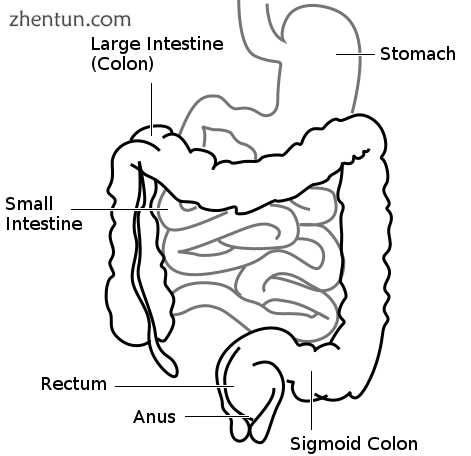
人体肠道的图
溃疡性结肠炎通常从直肠到结肠连续。 根据疾病扩展的程度,根据受累程度对疾病进行分类:
远端结肠炎,可用灌肠治疗:[14]
直肠炎:仅限于直肠受累。
直肠乙状结肠炎:直肠乙状结肠的参与,结肠部分与直肠相邻。
左侧结肠炎:沿着患者左侧延伸的降结肠的参与,直至脾弯曲和横结肠的开始。
广泛的结肠炎,炎症超出灌肠范围:
全结肠炎:整个结肠的参与,从直肠延伸到盲肠,小肠从此开始。
疾病严重程度
Colonic pseudopolyps of a patient with intractable ulcerative colitis. Colectomy specimen.
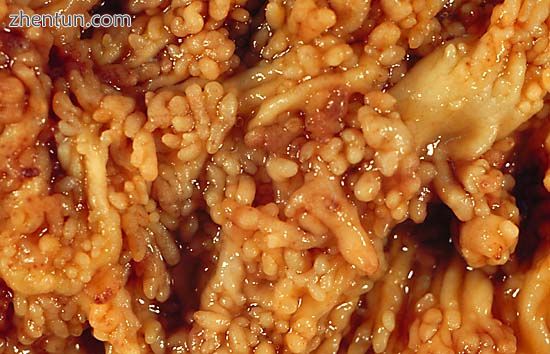
顽固性溃疡性结肠炎患者的结肠假性息肉。结肠切除标本。
除了参与程度之外,人们的特征还在于疾病的严重程度。[14]
轻度疾病与每天少于四次粪便相关,有或没有血液,没有全身毒性迹象,以及正常的红细胞沉降率(ESR)或C-反应蛋白(CRP)。可能会出现轻微的腹痛或痉挛。患者可能认为他们是便秘的,实际上他们正在经历里急后重,这是一种持续的感觉,需要排空肠,伴随着无意识的紧张努力,疼痛和痉挛,很少或没有粪便输出。直肠疼痛并不常见。
中度疾病每天与超过四种粪便相关,但毒性最小。患者可能出现贫血(不需要输血),中度腹痛和低烧,38至39°C(100至102°F)。
严重疾病,与每天六次以上的血便相关或可观察到的大量和显着的血性肠蠕动,以及由发热,心动过速,贫血或ESR或CRP升高所证实的毒性证据。
暴发性疾病与每日十次排便,持续出血,毒性,腹部压痛和扩张,输血需求和结肠扩张(扩张)相关。此类患者的炎症可能超出粘膜层,导致结肠运动受损并导致中毒性巨结肠。如果涉及浆膜,则可能发生结肠穿孔。除非得到治疗,暴发性疾病很快就会导致死亡。
肠外功能
Patients with ulcerative colitis can occasionally have aphthous ulcers involving the tongue, lips, p ...
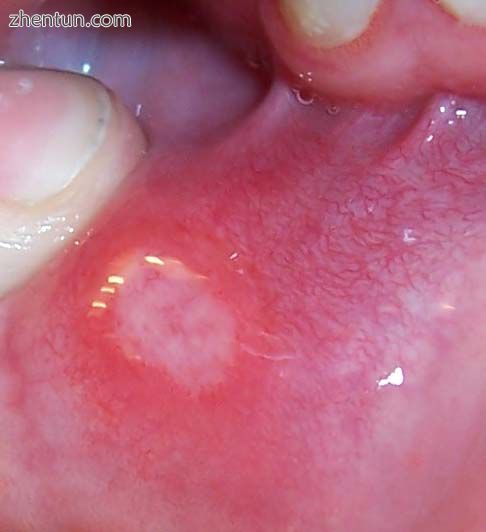
溃疡性结肠炎患者偶尔会出现舌痛,口唇,腭和咽部的口疮性溃疡
由于溃疡性结肠炎被认为具有全身性(即自身免疫性)起源,患者可能出现合并症,导致结肠外的症状和并发症。据报道,这种肠外表现的频率在6%到47%之间,[15]并包括以下内容:
口疮性溃疡
眼科
发炎或葡萄膜炎,这是眼睛虹膜的炎症
巩膜外层炎
肌肉骨骼:
血清阴性关节炎,可以是大关节性少关节炎(影响一个或两个关节),或可能影响手脚的许多小关节
强直性脊柱炎,脊柱关节炎
骶髂关节炎,下脊柱关节炎
皮肤(与皮肤有关):
结节性红斑,是一种脂膜炎,或涉及下肢的皮下组织炎症
坏疽性脓皮病,是一种涉及皮肤的疼痛性溃疡病变
深静脉血栓形成和肺栓塞
自身免疫性溶血性贫血
杵状指,手指末端的畸形。
原发性硬化性胆管炎,一种引起胆管炎症的独特疾病
原因
没有直接原因导致溃疡性结肠炎,但许多可能的因素如遗传和压力起作用。
遗传因素
溃疡性结肠炎病因的遗传成分可以基于以下假设:[16]
家庭中溃疡性结肠炎的聚集。
相同的双胞胎一致率为10%,双卵双胞胎一致率为3%[17]
种族差异在发病率
遗传标记和联系
基因组的12个区域可能与溃疡性结肠炎有关,包括按照它们的发现顺序,染色体16,12,6,14,5,19,1和3,[18]但这些基因座都没有一致显示有缺陷,表明该疾病受多种基因的影响。例如,染色体带1p36是一个被认为与炎症性肠病有关的区域。[19]
一些推定的区域编码转运蛋白,例如OCTN1和OCTN2。其他潜在区域涉及细胞支架蛋白,例如MAGUK家族。工作中甚至可能存在人类白细胞抗原关联。事实上,6号染色体上的这种联系可能是遗传候选者中最有说服力和最一致的。[18]
已经记录了多种自身免疫疾病,包括溃疡性结肠炎,克罗恩病,乳糜泻,疱疹样皮炎,糖尿病,全身性和盘状性狼疮,类风湿性关节炎,强直性脊柱炎,硬皮病,干燥综合征和巩膜炎等神经病变和皮肤遗传性卟啉症。对于患有自身免疫性疾病的家庭,医生应对卟啉症保持高度警惕,并且必须注意使用潜在的卟啉原药物,包括柳氮磺胺吡啶。
环境因素
已经针对导致溃疡性结肠炎发病机理的环境因素提出了许多假设。它们包括以下内容:
饮食:由于结肠暴露于许多可能促进炎症的饮食物质,因此假设饮食因素在溃疡性结肠炎和克罗恩病的发病机理中起作用。很少有研究调查这种关联;一项研究表明,精制糖与溃疡性结肠炎的患病率无关。[20]大量摄入不饱和脂肪和维生素B6可能会增加患溃疡性结肠炎的风险。[21]其他可能影响疾病发展和/或复发的饮食因素包括肉类蛋白质和酒精饮料。[22] [23]具体而言,硫已被调查为涉及溃疡性结肠炎的病因,但这是有争议的。[24]已经在UC患者和该疾病的动物模型中研究了硫限制饮食。除了饮食之外,硫作为病原因子的理论与肠道微生物群和粘膜硫化物解毒有关[25] [26] [27]。
母乳喂养:一些关于保护母乳喂养在炎症性肠病发展中的报道相互矛盾。一项意大利研究显示出潜在的保护作用。[28]
一项关于异维A酸的研究发现,溃疡性结肠炎的发病率略有增加。[29]
自身免疫性疾病
溃疡性结肠炎是一种自身免疫性疾病,其特征是T细胞浸润结肠[30]。与克罗恩病相反,克罗恩病可影响结肠外的胃肠道区域,溃疡性结肠炎通常涉及直肠并且局限于结肠,偶尔涉及回肠。这种所谓的“反洗回肠炎”可能发生在10-20%的全结肠炎患者中,并且被认为具有很小的临床意义。[31]溃疡性结肠炎也可能与在消化系统外的身体许多区域产生症状的合并症有关。手术切除大肠通常可以治愈这种疾病。[14]
另类理论
风险因素
克罗恩病溃疡性结肠炎
吸烟吸烟者风险较高吸烟者风险较低[32]
年龄通常发病
15和30年[33]之间的高峰发病率
15年和25年
溃疡性结肠炎患者的硫酸盐还原菌水平往往较高,这可能表明肠道中的硫化氢水平较高。另一种理论认为,这种疾病的症状可能是由硫化氢对肠道细胞的毒性作用引起的。[34]
病理生理学
病理生理学
克罗恩病溃疡性结肠炎
细胞因子反应与Th17相关[35]与Th2模糊相关
在一些患有溃疡性结肠炎的患者中观察到结肠硫酸盐还原细菌的量增加,导致更高浓度的有毒气体硫化氢。人结肠粘膜由固有层中的结肠上皮屏障和免疫细胞维持(参见肠粘膜屏障)。 N-丁酸盐是一种短链脂肪酸,通过β氧化途径被氧化成二氧化碳和酮体。已经表明,N-丁酸盐有助于为这种上皮屏障提供营养。研究已经提出硫化氢通过中断短链乙酰辅酶A脱氢酶(该途径中的酶)而在损害该β-氧化途径中起作用。此外,有人提出,吸烟在溃疡性结肠炎中的保护作用是由于香烟烟雾中的氰化氢与硫化氢反应生成无毒的异硫氰酸酯,从而抑制硫化物中断该途径。[36]一项不相关的研究表明,红肉和酒精中含有的硫可能导致缓解期患者复发的风险增加。[34]
溃疡性结肠炎患者通常出现直肠出血,腹泻,里急后重(迫切需要排空肠道,但随着小便通过)和下腹部疼痛。临床表现的疾病严重程度对于确定适当的治疗非常重要。患有轻度活动性疾病的患者每天排便少于4次并且没有毒性迹象。患有中度严重UC的个体出血更频繁。大约70%的溃疡性结肠炎患者在出现时会出现中度活动性疾病。患有严重疾病的患者会出现发烧,心动过速和贫血的毒性迹象。暴发性或中毒性结肠炎或中毒性巨结肠患者一天内排便通常超过10次,持续出血,腹胀和压痛,以及水肿的放射学证据,在某些情况下还有肠扩张。这些人通常需要立即进行结肠切除术,因为10%的人在手术时有穿孔结肠。
诊断
H&E stain of a colonic biopsy showing a crypt abscess, a classic finding in ulcerative colitis
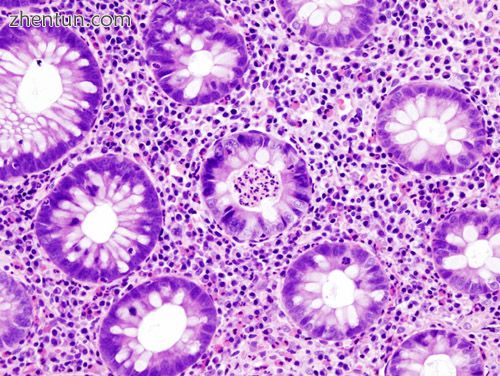
结肠活检的H&E染色显示隐窝脓肿,这是溃疡性结肠炎的典型发现
溃疡性结肠炎的初步诊断检查包括以下内容:[14] [37]
进行全血细胞计数以检查贫血症;偶尔会看到血小板增多,血小板计数很高
进行电解质研究和肾功能测试,因为慢性腹泻可能与低钾血症,低镁血症和肾前性衰竭有关。
进行肝功能检查以筛查胆管受累:原发性硬化性胆管炎。
X-射线
尿液分析
大便文化,以排除寄生虫和传染性原因。
可以测量红细胞沉降速率,沉降速率升高表明存在炎症过程。
可以测量C-反应蛋白,其中升高的水平是炎症的另一指示。
乙状结肠镜检查是一种内窥镜检查,可以在灌肠试验后检测大肠溃疡的存在。
虽然溃疡性结肠炎是一种病因不明的疾病,但应该对被认为引发疾病的异常因素进行调查。[14]
简单的临床结肠炎活动指数创建于1998年,用于评估症状的严重程度。[38] [39]
内镜
Biopsy sample (H&E stain) that demonstrates marked lymphocytic infiltration (blue/purple) of the i ...
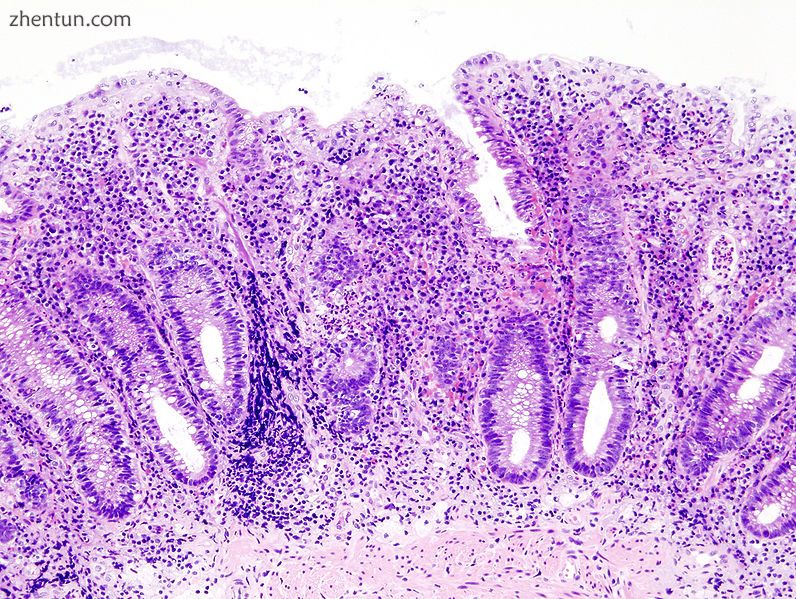
活检样本(H&E染色)显示肠粘膜明显的淋巴细胞浸润(蓝色/紫色)和隐窝的结构扭曲。
诊断溃疡性结肠炎的最佳方法仍然是内镜检查。只有当UC的诊断不清楚时,才尝试对盲肠进行全结肠镜检查并进入回肠末端。否则,灵活的乙状结肠镜检查足以支持诊断。如果遇到严重的结肠炎,医生可以选择限制检查的程度,以尽量减少结肠穿孔的风险。溃疡性结肠炎的内镜检查结果如下:
结肠血管外观丧失
红斑(或粘膜发红)和粘膜脆性
表面溃疡,可能是融合的,和
假息肉。
溃疡性结肠炎通常是从直肠连续的,直肠几乎普遍存在。肛周疾病很少见。内窥镜检查的程度范围从直肠炎或直肠炎症到左侧结肠炎,到全结肠炎,即涉及升结肠的炎症。
组织学
对粘膜进行活组织检查以明确诊断UC并将其与克罗恩病区分开来,克罗恩病在临床上进行不同的管理。通常在内窥镜检查时采集微生物样品。溃疡性结肠炎的病理学通常涉及隐窝结构的变形,隐窝炎症(隐窝炎),直接隐窝脓肿以及固有层中的出血或炎性细胞。在临床表现不清楚的情况下,组织形态学分析通常在确定诊断和管理方面起关键作用。相比之下,活组织检查分析可能是不确定的,因此疾病的临床进展必须通知其治疗。
鉴别诊断
Endoscopic image of ulcerative colitis affecting the left side of the colon. The image shows conflue ...
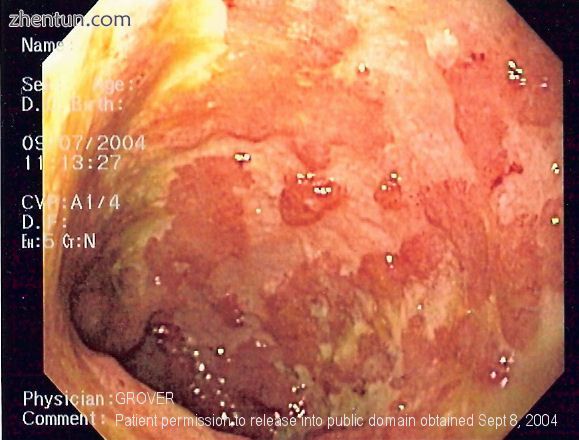
溃疡性结肠炎的内窥镜图像影响结肠的左侧。该图像显示融合的浅表溃疡和粘膜结构的丧失。克罗恩病在外观上可能相似,这一事实可以使诊断UC成为一项挑战。
以下情况可能与溃疡性结肠炎的情况类似,应排除在外:
克罗恩病
传染性结肠炎,通常在粪便培养物中检测到
溶组织内阿米巴(Entamoeba histolytica)是一种引起肠道炎症的原生动物寄生虫。少数病例被误诊为UC,因使用皮质类固醇而导致预后不良[40]。
伪膜性结肠炎,或艰难梭菌相关性结肠炎,抗生素给药后常见细菌性紊乱
缺血性结肠炎,肠道供血不足,通常影响老年人
先前盆腔放疗患者的放射性结肠炎
化学结肠炎是由灌肠或其他手术中的刺激性化学物质引入结肠引起的。
恶性肿瘤[41] - 癌症可能表现为结肠炎急性发作,反之亦然。排除恶性肿瘤非常重要,特别是当结肠炎难以治疗时。
模仿溃疡性结肠炎症状的最常见疾病是克罗恩病,因为两者都是炎症性肠病,可以影响具有相似症状的结肠。区分这些疾病很重要,因为他们的课程和治疗可能会有所不同。然而,在某些情况下,可能无法区分,在这种情况下,疾病被归类为不确定性结肠炎。
管理
主要文章:溃疡性结肠炎的管理
溃疡性结肠炎的标准治疗取决于受累程度和疾病严重程度。目标是最初用药物诱导缓解,然后给予维持药物以防止复发。诱导缓解和维持缓解的概念非常重要。用于诱导和维持缓解的药物有些重叠,但治疗方法不同。医生首先指导治疗诱导缓解,包括缓解症状和结肠内膜的粘膜愈合,然后长期治疗以维持缓解并预防并发症。急性严重溃疡性结肠炎需要住院,排除感染和皮质类固醇。[45]
对于该疾病的急性期,可推荐低纤维饮食。[46] [47]
药物治疗
溃疡性结肠炎可以用许多药物治疗,包括5-ASA药物,如柳氮磺胺吡啶和美沙拉嗪。皮质类固醇如泼尼松也可以使用,因为它们具有免疫抑制和短期治疗作用,但由于它们的风险大于它们的益处,因此它们不能长期用于治疗。免疫抑制药物如硫唑嘌呤和生物制剂如英夫利昔单抗和阿达木单抗仅在人们不能用5-ASA和皮质类固醇达到缓解时给予。由于其可能的风险因素,这些治疗的使用较少,包括但不限于青少年和成人患癌症的风险增加,[48]结核病,以及新的或恶化的心力衰竭(这些副作用很少见)。布地奈德制剂于2013年1月被FDA批准用于治疗活动性溃疡性结肠炎。[49] Tofacitinib于2018年在美国被批准用于治疗中度至重度活动性溃疡性结肠炎,这是第一种在这种情况下长期使用的口服药物。[50]关于甲氨蝶呤的证据并没有显示出对溃疡性结肠炎患者产生缓解的益处。[51]标签外使用环孢素和他克莫司等药物已显示出一些益处。[52] [53] Fexofenadine是一种用于治疗过敏症的抗组胺药,在一些研究中显示出联合治疗的前景。[54] [55]恰好,非索非那定的低胃肠道吸收(或高吸收药物胃肠分泌)导致炎症部位的更高浓度。因此,药物可通过涉及的胃肠肥大细胞局部减少组胺分泌并减轻炎症。
氨基水杨酸
柳氮磺胺吡啶是治疗轻度至中度溃疡性结肠炎50多年的主要药物。 1977年,研究表明5-氨基水杨酸(5-ASA,美沙拉嗪/美沙拉嗪)是柳氮磺吡啶的治疗活性成分[56]。已经开发了许多5-ASA药物,目的是将活性化合物递送至大肠以维持治疗功效,但减少与柳氮磺胺吡啶中的磺胺吡啶部分相关的副作用。口服5-ASA药物在轻度至中度溃疡性结肠炎的诱导和维持缓解方面特别有效。[57] [58] 5-ASA的直肠栓剂,泡沫或液体灌肠剂用于影响直肠,乙状结肠或降结肠的结肠炎,并且已被证明是有效的,特别是当与口服治疗结合时。[59]
生物制品
诸如TNF抑制剂英夫利昔单抗,阿达木单抗和戈利木单抗的生物治疗通常用于治疗不再对皮质类固醇有反应的UC患者。 Tofacitinib,vedolizumab和etrolizumab也可以在UC中产生良好的临床缓解和缓解率[7]。通常,这些药物仅在其他选择用尽时使用(即,该人已接受并且对高剂量皮质类固醇和免疫调节剂如硫唑嘌呤和美沙拉嗪没有良好反应)。
与氨基水杨酸盐​​不同,生物制剂可引起严重的副作用,例如发生肠外癌症的风险增加,[48]心力衰竭;和免疫系统的削弱,导致免疫系统清除感染和潜伏感染如结核病再激活的能力下降。因此,对这些治疗方法的患者进行密切监测,并且通常每年至少进行一次肝炎和肺结核检查。
尼古丁
与克罗恩病不同,溃疡性结肠炎在吸烟者中的患病率低于非吸烟者[60] [61]。使用透皮尼古丁贴片的研究显示临床和组织学改善。[62]
在英国进行的一项双盲,安慰剂对照研究中,48.6%使用尼古丁贴片的患者与其标准治疗相结合,显示症状完全消退。另一项在美国进行的随机,双盲,安慰剂对照,单中心临床试验显示,39%使用该贴片的患者显示出显着改善,而安慰剂组为9%。[63]使用透皮尼古丁贴剂而不添加其他标准治疗如美沙拉嗪具有类似于不使用尼古丁的标准治疗的复发发生率。
补铁
胃肠道逐渐失血以及慢性炎症常导致贫血,专业指南建议常规监测贫血,每3个月在活动性疾病中重复进行血液检测,每年静脉疾病。[64]适当的疾病控制通常会改善慢性病的贫血,但缺铁性贫血应该用铁补充剂治疗。施用治疗的形式取决于贫血的严重程度和遵循的指导方针。有人建议首先使用肠外铁,因为患者对胃的反应更快,与胃肠道副作用较少有关,并且与依从性问题无关。[65]其他人则需要首先使用口服铁剂,因为患者最终会有反应,许多人会忍受副作用。[64] [66]所有指南都建议在严重贫血(血红蛋白水平低于100 g / L)的情况下应给予肠外铁。
手术
管理
与克罗恩病不同,溃疡性结肠炎的胃肠道方面通常可以通过手术切除大肠来治愈,但是肠外症状可能持续存在。如果出现以下情况,则必须执行此程序:放血,明显穿孔或记录或强烈怀疑的癌。对于患有严重结肠炎或中毒性巨结肠的患者也需要手术。患有致残症状且对药物无反应的症状的患者可能希望考虑手术是否会改善生活质量。
溃疡性结肠炎影响肠道外的许多身体部位。在极少数情况下,疾病的肠外表现可能需要切除结肠。[14]
影响大多数大肠的溃疡性结肠炎的另一种手术选择称为回肠 - 肛门袋手术。这是一个两到三步的过程,除了直肠残端和肛门外,大肠被移除,并进行临时回肠造口术。手术的下一部分可以一步或两步完成,并且通常在每次手术前每隔六至十二个月进行一次。
在手术的下一步中,内部小袋由患者自己的小肠制成,然后将该小袋内部钩回到直肠残端,以便患者可以再次具有合理功能的肠系统,全部在内部。此时临时回肠造口术可以逆转,以便患者内化肠功能,或者,在手术的另一个步骤中,小袋和直肠残端吻合口可以留在患者体内,在患者仍然痊愈一段时间使用回肠造口术治疗肠道功能。然后,在随后的手术中,回肠造口术被逆转并且患者再次内化肠功能。
白细胞单采
一种白细胞单采,称为粒细胞和单核细胞吸附单采,仍需要进行大规模试验以确定其是否有效。[70]小规模试验的结果暂时是积极的。[71]
细菌重新定殖
在许多随机临床试验中,益生菌已证明有助于治疗溃疡性结肠炎。特定类型的益生菌如大肠埃希氏菌Nissle已被证明可在一些患者中诱导缓解长达一年。[72]据说具有类似作用的另一种类型的益生菌是嗜酸乳杆菌。[引证需要]据说益生菌通过平息导致该疾病的一些正在进行的炎症起作用,这反过来允许身体动员树突细胞,否则被称为信使免疫细胞。然后,这些细胞能够产生其他T细胞,通过重新平衡系统性炎症,进一步帮助恢复肠道平衡。[73]
粪便细菌疗法涉及通过粪便灌肠输注人益生菌。溃疡性结肠炎通常需要比艰难梭菌感染更长时间的细菌疗法治疗才能成功,这可能是由于愈合溃疡上皮所需的时间。溃疡性结肠炎的反应可能非常有利,一项研究报告67.7%的患者完全缓解。[74]这表明溃疡性结肠炎的病因可能是先前仍然未知的病原体感染。这种初始感染自然消退,但不知何故导致结肠细菌菌群失衡,导致炎症循环,可以通过用健康肠道细菌“重新定殖”结肠来打破炎症循环。据报道,有几例患者在13年内一直处于缓解期。[75]
替代药物
大约21%的炎症性肠病患者使用替代疗法。[76]各种饮食疗法显示出前景,但在推荐之前需要进一步研究。[77]
根据体外研究,动物研究和初步人体研究,褪黑激素可能是有益的。[78]
膳食纤维,意味着难以消化的植物物质,几十年来一直被推荐用于维持肠道功能。特别值得注意的是来自芸苔的纤维,它似乎含有可溶性成分,能够在煮熟之前沿着整个人体消化道逆转溃疡。[79]
鱼油和源自鱼油的二十碳五烯酸(EPA)抑制白三烯活性,后者可能是炎症的关键因素。作为IBD疗法,没有关于支持的决定性研究,也没有推荐的剂量。但是,对于其他条件,建议使用180至1500毫克/天的EPA剂量,最常见的是心脏病。[80]鱼油还含有维生素D,其中许多IBD患者缺乏维生素D. [81]
短链脂肪酸(丁酸盐)灌肠。结肠中的上皮细胞使用来自肠内容物的丁酸盐作为能量来源。可用的丁酸盐量朝向直肠减少。已经提出下肠中丁酸盐水平不足是该疾病的促成因素。这可以通过丁酸盐灌肠来解决。[82]然而,结果并不是决定性的。[引证需要]
溃疡性结肠炎患者使用草药。含有巯基的化合物可能会对溃疡性结肠炎产生影响(在类似的假设下,柳氮磺胺吡啶的磺胺部分除活性5-ASA成分外还可能具有活性)。[83]一项随机对照试验评估了非处方药物S-甲基蛋氨酸,发现当药物与口服柳氮磺胺吡啶联合使用时,复发率显着下降。[84]
蠕虫疗法是使用肠道寄生线虫来治疗溃疡性结肠炎,并且基于卫生假说的前提。研究表明,蠕虫改善并且比每日皮质类固醇更有效地阻断化学诱导的小鼠结肠炎,[85] [86]以及故意蠕虫感染恒河猴的特发性慢性腹泻(一种类似于人类溃疡性结肠炎的病症)的试验)导致5只受治疗动物中有4只症状缓解。[87]一项关于人类Trichuris suis ova的随机对照试验发现该疗法安全有效,[88]并且正在进行进一步的人体试验。
姜黄素(姜黄)疗法与服用药物美沙拉嗪或柳氮磺胺吡啶相结合,对于维持静息性溃疡性结肠炎患者的缓解可能是有效和安全的。姜黄素单独治疗静息性溃疡性结肠炎的效果尚不清楚。[89]
进展或缓解
本节不引用任何来源。请通过向可靠来源添加引文来帮助改进此部分。无法查证的内容可能被提出异议而移除。 (2012年1月)(了解如何以及何时删除此模板消息)
患有溃疡性结肠炎的患者通常具有间歇性病程,疾病不活动期与疾病的“突发”交替。患有直肠炎或左侧结肠炎的患者通常具有更良性的疗程:在患有疾病的近端仅有15%的患者进展,并且在没有任何治疗的情况下高达20%的患者可以持续缓解。患有更广泛疾病的患者不太可能维持缓解,但缓解率与疾病的严重程度无关。
结直肠癌
如果累及超过脾曲,10年后溃疡性结肠炎患者的结直肠癌风险显着增加。那些只有直肠炎或直肠乙状结肠炎的患者通常没有增加的风险。[14]建议患者进行结肠镜检查并随机进行活组织检查,以便在一到两年的间隔期内寻找发病8年后的发育异常。[91]
原发性硬化性胆管炎
溃疡性结肠炎与原发性硬化性胆管炎(PSC)有显着相关性,PSC是一种小胆管和大胆管的进行性炎症性疾病。多达5%的溃疡性结肠炎患者可能会发展为原发性硬化性胆管炎。[92]
死亡
研究尚未发现溃疡性结肠炎患者死于背景人群的总体风险存在差异。死因分布可能与背景人口的分布不同。[93]人们认为这种疾病主要影响生活质量,而不是生命。
其他长期功能
在慢性溃疡性结肠炎中可见的变化包括粒度,粘膜血管模式的丧失,haustra的丧失,回盲瓣的消失,粘膜桥接,狭窄和假性息肉[94]。
流行病学
UC和克罗恩病的地理分布在世界范围内相似,[95]加拿大,新西兰,苏格兰和英国的UC每年新发病例数最多。[96]它最常见于15至25岁之间。第二个发病高峰是生命的第六个十年。[97]总体而言,与欧洲南部地区[98]和美国相比,北部地区的比率更高。[99]
与克罗恩病一样,在德系犹太人中加州大学的比率更高,而在其他犹太血统,非犹太高加索人,非洲人,西班牙裔和亚洲人中逐渐减少。[31]阑尾炎[100]在20岁之前的阑尾切除术[100]和目前的烟草使用[101]对UC的发展具有保护作用(尽管以前的烟草使用与发生该疾病的风险较高有关。[101])
美国
截至2004年,美国UC新病例的数量在每年每100,000人中2.2至14.3之间。[102]受影响的美国人数为每10万人37至246人。[102]
加拿大
在加拿大,1998年至2000年期间,每年新发病例数为每10万人12.9例或新发病例4,500例。受影响的人数估计为每100,000人211人或104,000人。[103]
英国
在英国,每10万人中就有10人每年新发病,而受影响的人数为每10万人中有243人。英国约有146,000人被诊断患有UC。[104]
研究
使用鞭虫鞭虫的蠕虫疗法已在爱荷华州的一项随机对照试验中显示,以显示溃疡性结肠炎患者的益处。[105]该疗法测试了卫生学假说,该假设认为发达国家患者的结肠中没有蠕虫可能导致炎症。蠕虫疗法和粪便细菌疗法在患病区域诱导特征性Th2白细胞反应,这是出乎意料的,因为溃疡性结肠炎被认为涉及Th2过量产生[106]。
Alicaforsen是第一代反义寡脱氧核苷酸,设计用于通过Watson-Crick碱基对相互作用特异性结合人ICAM-1信使RNA,以抑制ICAM-1的表达。[107] ICAM-1传播炎症反应,促进白细胞(白细胞)的外渗和活化进入发炎组织。[107]在溃疡性结肠炎患者的发炎肠粘膜内观察到ICAM-1的表达增加,其中ICAM-1过量产生与疾病活动相关[108]。这表明ICAM-1是治疗溃疡性结肠炎的潜在治疗靶点。[109]
腔内存在的革兰氏阳性细菌可能与延长溃疡性结肠炎的复发时间有关。[110]
正在开发的一系列药物通过选择性地靶向称为KCa3.1的炎症信号级联中的离子通道来破坏炎症过程。[111]在大鼠和小鼠的临床前研究中,KCa3.1的抑制破坏了Th1细胞因子IL-2和TNF-α的产生,并且与柳氮磺胺吡啶一样有效地降低了结肠炎症。[111]
值得注意的案例
主要文章:被诊断患有溃疡性结肠炎的人员名单
参考:
1. "Ulcerative Colitis". NIDDK. September 2014. Archived from the original on 28 July 2016. Retrieved 3 August 2016.
2. Wanderås, Magnus Hofrenning; Moum, Bjørn A; Høivik, Marte Lie; Hovde, Øistein (2016-05-06). "Predictive factors for a severe clinical course in ulcerative colitis: Results from population-based studies". World Journal of Gastrointestinal Pharmacology and Therapeutics. 7 (2): 235–241. doi:10.4292/wjgpt.v7.i2.235. ISSN 2150-5349. PMC 4848246 Freely accessible. PMID 27158539.
3. Runge, Marschall S.; Greganti, M. Andrew (2008). Netter's Internal Medicine E-Book. Elsevier Health Sciences. p. 428. ISBN 9781437727722.
4. Molodecky, NA; Soon, IS; Rabi, DM; Ghali, WA; Ferris, M; Chernoff, G; Benchimol, EI; Panaccione, R; Ghosh, S; Barkema, HW; Kaplan, GG (January 2012). "Increasing incidence and prevalence of the inflammatory bowel diseases with time, based on systematic review". Gastroenterology. 142 (1): 46–54.e42; quiz e30. doi:10.1053/j.gastro.2011.10.001. PMID 22001864.
5. GBD 2015 Mortality and Causes of Death, Collaborators. (8 October 2016). "Global, regional, and national life expectancy, all-cause mortality, and cause-specific mortality for 249 causes of death, 1980-2015: a systematic analysis for the Global Burden of Disease Study 2015". Lancet. 388 (10053): 1459–1544. doi:10.1016/s0140-6736(16)31012-1. PMC 5388903 Freely accessible. PMID 27733281.
6. Ford, AC; Moayyedi, P; Hanauer, SB (5 February 2013). "Ulcerative colitis". BMJ (Clinical research ed.). 346: f432. doi:10.1136/bmj.f432. PMID 23386404.
7. Akiho, Hirotada; Yokoyama, Azusa; Abe, Shuichi; Nakazono, Yuichi; Murakami, Masatoshi; Otsuka, Yoshihiro; Fukawa, Kyoko; Esaki, Mitsuru; Niina, Yusuke (2015-11-15). "Promising biological therapies for ulcerative colitis: A review of the literature". World Journal of Gastrointestinal Pathophysiology. 6 (4): 219–227. doi:10.4291/wjgp.v6.i4.219. ISSN 2150-5330. PMC 4644886 Freely accessible. PMID 26600980.
8. Danese, S; Fiocchi, C (3 November 2011). "Ulcerative colitis". The New England Journal of Medicine. 365 (18): 1713–25. doi:10.1056/NEJMra1102942. PMID 22047562.
9. GBD 2015 Disease and Injury Incidence and Prevalence, Collaborators. (8 October 2016). "Global, regional, and national incidence, prevalence, and years lived with disability for 310 diseases and injuries, 1990-2015: a systematic analysis for the Global Burden of Disease Study 2015". Lancet. 388 (10053): 1545–1602. doi:10.1016/S0140-6736(16)31678-6. PMC 5055577 Freely accessible. PMID 27733282.
10. Adams, James G. (2012). Emergency Medicine E-Book: Clinical Essentials (Expert Consult -- Online). Elsevier Health Sciences. p. 304. ISBN 1455733946.
11. internetmedicin.se > Inflammatorisk tarmsjukdom, kronisk, IBD By Robert Löfberg. Retrieved Oct 2010 Translate.
12. Hanauer SB, Sandborn W (2001-03-01). "Management of Crohn's disease in adults" (PDF). American Journal of Gastroenterology. 96 (3): 635–43. doi:10.1111/j.1572-0241.2001.03671.x. PMID 11280528. Retrieved 2009-11-07.
13. Hanauer SB (1996). "Inflammatory bowel disease". The New England Journal of Medicine. 334 (13): 841–8. doi:10.1056/NEJM199603283341307. PMID 8596552.
14. Kornbluth A, Sachar DB (2004). "Ulcerative colitis practice guidelines in adults (update): American College of Gastroenterology, Practice Parameters Committee". The American Journal of Gastroenterology. 99 (7): 1371–85. doi:10.1111/j.1572-0241.2004.40036.x. PMID 15233681.
15. Langan RC, Gotsch PB, Krafczyk MA, Skillinge DD (November 2007). "Ulcerative colitis: diagnosis and treatment" (PDF). American Family Physician. 76 (9): 1323–30. PMID 18019875. Archived (PDF) from the original on 20 May 2013.
16. Orholm M, Binder V, Sørensen TI, Rasmussen LP, Kyvik KO (2000). "Concordance of inflammatory bowel disease among Danish twins. Results of a nationwide study". Scandinavian Journal of Gastroenterology. 35 (10): 1075–81. doi:10.1080/003655200451207. PMID 11099061.
17. Tysk C, Lindberg E, Järnerot G, Flodérus-Myrhed B (1988). "Ulcerative colitis and Crohn's disease in an unselected population of monozygotic and dizygotic twins. A study of heritability and the influence of smoking". Gut. 29 (7): 990–996. doi:10.1136/gut.29.7.990. PMC 1433769 Freely accessible. PMID 3396969.
18. Baumgart DC, Sandborn WJ (May 2007). "Inflammatory bowel disease: clinical aspects and established and evolving therapies". The Lancet. 369 (9573): 1641–57. doi:10.1016/S0140-6736(07)60751-X. PMID 17499606. Retrieved 2009-11-04.
19. Cho JH, Nicolae DL, Ramos R, Fields CT, Rabenau K, Corradino S, Brant SR, Espinosa R, LeBeau M, Hanauer SB, Bodzin J, Bonen DK (2000). "Linkage and linkage disequilibrium in chromosome band 1p36 in American Chaldeans with inflammatory bowel disease" (PDF). Human Molecular Genetics. 9 (9): 1425–32. doi:10.1093/hmg/9.9.1425. PMID 10814724.
20. Järnerot G, Järnmark I, Nilsson K (1983). "Consumption of refined sugar by patients with Crohn's disease, ulcerative colitis, or irritable bowel syndrome". Scandinavian Journal of Gastroenterology. 18 (8): 999–1002. doi:10.3109/00365528309181832. PMID 6673083.
21. Geerling BJ, Dagnelie PC, Badart-Smook A, Russel MG, Stockbrügger RW, Brummer RJ (April 2000). "Diet as a risk factor for the development of ulcerative colitis". The American Journal of Gastroenterology. 95 (4): 1008–13. doi:10.1111/j.1572-0241.2000.01942.x. PMID 10763951.
22. Jowett SL, Seal CJ, Pearce MS, Phillips E, Gregory W, Barton JR, Welfare MR (October 2004). "Influence of dietary factors on the clinical course of ulcerative colitis: a prospective cohort study". Gut. 53 (10): 1479–84. doi:10.1136/gut.2003.024828. PMC 1774231 Freely accessible. PMID 15361498.
23. Andersen V, Olsen A, Carbonnel F, Tjønneland A, Vogel U (March 2012). "Diet and risk of inflammatory bowel disease". Digestive and Liver Disease. 44 (3): 185–94. doi:10.1016/j.dld.2011.10.001. PMID 22055893.
24. Tilg H, Kaser A (1 October 2004). "Diet and relapsing ulcerative colitis: take off the meat?". Gut. 53 (10): 1399–1401. doi:10.1136/gut.2003.035287. PMC 1774255 Freely accessible. PMID 15361484.
25. Moore J, Babidge W, Millard S, Roediger W (January 1998). "Colonic luminal hydrogen sulfide is not elevated in ulcerative colitis". Digestive Diseases and Sciences. 43 (1): 162–5. doi:10.1023/A:1018848709769. PMID 9508519.
26. Jørgensen J, Mortensen PB (August 2001). "Hydrogen sulfide and colonic epithelial metabolism: implications for ulcerative colitis". Digestive Diseases and Sciences. 46 (8): 1722–32. doi:10.1023/A:1010661706385. PMID 11508674.
27. Picton R, Eggo MC, Langman MJ, Singh S (February 2007). "Impaired detoxication of hydrogen sulfide in ulcerative colitis?". Digestive Diseases and Sciences. 52 (2): 373–8. doi:10.1007/s10620-006-9529-y. PMID 17216575.
28. Corrao G, Tragnone A, Caprilli R, Trallori G, Papi C, Andreoli A, Di Paolo M, Riegler G, Rigo GP, Ferraù O, Mansi C, Ingrosso M, Valpiani D (1998). "Risk of inflammatory bowel disease attributable to smoking, oral contraception and breastfeeding in Italy: a nationwide case-control study. Cooperative Investigators of the Italian Group for the Study of the Colon and the Rectum (GISC)" (PDF). International Journal of Epidemiology. 27 (3): 397–404. doi:10.1093/ije/27.3.397. PMID 9698126.
29. Wolverton, SE; Harper, JC (April 2013). "Important controversies associated with isotretinoin therapy for acne". American Journal of Clinical Dermatology. 14 (2): 71–6. doi:10.1007/s40257-013-0014-z. PMID 23559397.
30. Ko IK, Kim BG, Awadallah A, Mikulan J, Lin P, Letterio JJ, Dennis JE (2010). "Targeting improves MSC treatment of inflammatory bowel disease". Mol. Ther. 18 (7): 1365–72. doi:10.1038/mt.2010.54. PMC 2911249 Freely accessible. PMID 20389289.
31. Fauci et al. Harrison's Internal Medicine, 17th ed. New York: McGraw-Hill Medical, 2008. ISBN 978-0-07-159991-7
32. Kornbluth A, Sachar DB (July 2004). "Ulcerative colitis practice guidelines in adults (update): American College of Gastroenterology, Practice Parameters Committee" (PDF). American Journal of Gastroenterology. 99 (7): 1371–85. doi:10.1111/j.1572-0241.2004.40036.x. PMID 15233681. Archived (PDF) from the original on April 6, 2008. Retrieved 2009-11-07.
33. Crohn's Disease Overview
34. Roediger WE, Moore J, Babidge W (1997). "Colonic sulfide in pathogenesis and treatment of ulcerative colitis" (PDF). Digestive Diseases and Sciences. 42 (8): 1571–9. doi:10.1023/A:1018851723920. PMID 9286219.
35. Elson CO, Cong Y, Weaver CT, Schoeb TR, McClanahan TK, Fick RB, Kastelein RA (2007). "Monoclonal anti-interleukin 23 reverses active colitis in a T cell-mediated model in mice". Gastroenterology. 132 (7): 2359–70. doi:10.1053/j.gastro.2007.03.104. PMID 17570211.
36. Levine J, Ellis CJ, Furne JK, Springfield J, Levitt, MD (1998). "Fecal Hydrogen Sulfide Production in Ulcerative Colitis". The American Journal of Gastroenterology. 93 (8): 83–87. doi:10.1111/j.1572-0241.1998.083_c.x. Archived from the original on 24 May 2009.
37. Ulcerative colitis at eMedicine
38. Walmsley, R S; Ayres, R C S; Pounder, R E; Allan, R N (1998). "A simple clinical colitis activity index". Gut. 43 (1): 29–32. doi:10.1136/gut.43.1.29. ISSN 0017-5749. PMC 1727189 Freely accessible.
39. Mardini, Houssam E.; Grigorian, Alla Y. (2014). "Probiotic Mix VSL#3 Is Effective Adjunctive Therapy for Mild to Moderately Active Ulcerative Colitis". Inflammatory Bowel Diseases. 20 (9): 1562–1567. doi:10.1097/MIB.0000000000000084. ISSN 1078-0998. PMID 24918321.
40. Shirley, DA; Moonah, S (July 2016). "Fulminant Amebic Colitis after Corticosteroid Therapy: A Systematic Review". PLoS neglected tropical diseases. 10 (7): e0004879. doi:10.1371/journal.pntd.0004879. PMID 27467600.
41. Kumar, Vivek; Soni, Parita; Garg, Mohit; Abduraimova, Madina; Harris, Jonathan (12 June 2017). "Kaposi Sarcoma Mimicking Acute Flare of Ulcerative Colitis". Journal of Investigative Medicine High Impact Case Reports. 5 (2): 232470961771351. doi:10.1177/2324709617713510.
42. Broomé U, Bergquist A (February 2006). "Primary sclerosing cholangitis, inflammatory bowel disease, and colon cancer". Seminars in Liver Disease. 26 (1): 31–41. doi:10.1055/s-2006-933561. PMID 16496231.
43. Shepherd NA (August 2002). "Granulomas in the diagnosis of intestinal Crohn's disease: a myth exploded?". Histopathology. 41 (2): 166–8. doi:10.1046/j.1365-2559.2002.01441.x. PMID 12147095.
44. Mahadeva U, Martin JP, Patel NK, Price AB (July 2002). "Granulomatous ulcerative colitis: a re-appraisal of the mucosal granuloma in the distinction of Crohn's disease from ulcerative colitis". Histopathology. 41 (1): 50–5. doi:10.1046/j.1365-2559.2002.01416.x. PMID 12121237.
45. Chen, J (Jul 2016). "Review article: acute severe ulcerative colitis - evidence-based consensus statements". Alimentary Pharmacology and Therapeutics. 44 (2): 127–44. doi:10.1111/apt.13670. PMID 27226344.
46. "Should You Try a Low-Residue Diet?". WebMD. WebMD. 25 October 2016. Archived from the original on 16 March 2017. Retrieved 29 April 2017.
47. Manual of Clinical Nutrition Management (PDF). Compass Group. 2013. Archived (PDF) from the original on 29 November 2015.
48. Axelrad, JE; Lichtiger, S; Yajnik, V (28 May 2016). "Inflammatory bowel disease and cancer: The role of inflammation, immunosuppression, and cancer treatment". World Journal of Gastroenterology (Review). 22 (20): 4794–801. doi:10.3748/wjg.v22.i20.4794. PMC 4873872 Freely accessible. PMID 27239106.
49. "Uceris Approved for Active Ulcerative Colitis". empr.com. 16 January 2013. Archived from the original on 18 January 2013. Retrieved 16 January 2013.
50. Commissioner, Office of the. "Press Announcements - FDA approves new treatment for moderately to severely active ulcerative colitis". www.fda.gov. Retrieved 2018-05-31.
51. Chande, N; Wang, Y; MacDonald, JK; McDonald, JW (27 August 2014). "Methotrexate for induction of remission in ulcerative colitis". The Cochrane Database of Systematic Reviews. 8 (8): CD006618. doi:10.1002/14651858.CD006618.pub3. PMID 25162749.
52. Krishnamoorthy, R., K. R. Abrams, N. Guthrie, S. Samuel, and T. Thomas. "PWE-237 Ciclosporin in acute severe ulcerative colitis: a meta-analysis". Gut 61, no. Suppl 2 (2012): A394-A394.
53. Ogata Haruhiko; Kato Jun; Hirai Fumihito; Hida Nobuyuki; Matsui Toshiyuki; Matsumoto Takayuki; Koyanagi Katsuyoshi; Hibi Toshifumi (2012). "Double‐blind, placebo‐controlled trial of oral tacrolimus (FK506) in the management of hospitalized patients with steroid‐refractory ulcerative colitis". Inflammatory Bowel Diseases. 18 (5): 803–808. doi:10.1002/ibd.21853. PMID 21887732.
54. Raithel, M; Winterkamp, S; Weidenhiller, M; Müller, S; Hahn, EG (2007). "Combination therapy using fexofenadine, disodium cromoglycate, and a hypoallergenic amino acid-based formula induced remission in a patient with steroid-dependent, chronically active ulcerative colitis". International Journal of Colorectal Disease. 22 (7): 833–839. doi:10.1007/s00384-006-0120-y. PMID 16944185.
55. Dhaneshwar, S; Gautam, H (August 2012). "Exploring novel colon-targeting antihistaminic prodrug for colitis". Journal of Physiology and Pharmacology. 63 (4): 327–337. PMID 23070081.
56. Azad Khan, AK; Piris, J; Truelove, SC (29 October 1977). "An experiment to determine the active therapeutic moiety of sulphasalazine". Lancet. 2 (8044): 892–5. PMID 72239.
57. Wang, Y; Parker, CE; Bhanji, T; Feagan, BG; MacDonald, JK (21 April 2016). "Oral 5-aminosalicylic acid for induction of remission in ulcerative colitis". The Cochrane Database of Systematic Reviews. 4: CD000543. doi:10.1002/14651858.CD000543.pub4. PMID 27101467.
58. Wang, Y; Parker, CE; Feagan, BG; MacDonald, JK (9 May 2016). "Oral 5-aminosalicylic acid for maintenance of remission in ulcerative colitis". The Cochrane Database of Systematic Reviews (5): CD000544. doi:10.1002/14651858.CD000544.pub4. PMID 27158764.
59. Marshall, JK; Thabane, M; Steinhart, AH; Newman, JR; Anand, A; Irvine, EJ (14 November 2012). "Rectal 5-aminosalicylic acid for maintenance of remission in ulcerative colitis". The Cochrane Database of Systematic Reviews. 11: CD004118. doi:10.1002/14651858.CD004118.pub2. PMID 23152224.
60. Calkins BM (1989). "A meta-analysis of the role of smoking in inflammatory bowel disease". Digestive Diseases and Sciences. 34 (12): 1841–54. doi:10.1007/BF01536701. PMID 2598752.
61. Lakatos PL, Szamosi T, Lakatos L (2007). "Smoking in inflammatory bowel diseases: good, bad or ugly?". World Journal of Gastroenterology. 13 (46): 6134–9. doi:10.3748/wjg.13.6134. PMC 4171221 Freely accessible. PMID 18069751.
62. Guslandi M (October 1999). "Nicotine treatment for ulcerative colitis". British Journal of Clinical Pharmacology. 48 (4): 481–4. doi:10.1046/j.1365-2125.1999.00039.x. PMC 2014383 Freely accessible. PMID 10583016. Archived from the original on 15 June 2013.
63. Sandborn WJ, Tremaine WJ, Offord KP, Lawson GM, Petersen BT, Batts KP, Croghan IT, Dale LC, Schroeder DR, Hurt RD (March 1997). "Transdermal nicotine for mildly to moderately active ulcerative colitis. A randomized, double-blind, placebo-controlled trial". Annals of Internal Medicine. 126 (5): 364–71. doi:10.7326/0003-4819-126-5-199703010-00004. PMID 9054280.
64. Goddard, A. F.; James, M. W.; McIntyre, A. S.; Scott, B. B.; British Society of Gastroenterology (2011). "Guidelines for the management of iron deficiency anaemia". Gut. 60 (10): 1309–1316. doi:10.1136/gut.2010.228874. PMC 1728199 Freely accessible. PMID 21561874.
65. Inflamm Bowel Dis 2007;13:1545–1553
66. Mowat C, Cole A, Windsor A, Ahmad T, Arnott I, Driscoll R, Mitton S, Orchard T, Rutter M, Younge L, Lees C, Ho GT, Satsangi J, Bloom S (May 2011). "Guidelines for the management of inflammatory bowel disease in adults". Gut. 60 (5): 571–607. doi:10.1136/gut.2010.224154. PMC 1867788 Freely accessible. PMID 21464096.
67. Agabegi ED, Agabegi SS (2008). "Inflammatory bowel disease (IBD)". Step-Up to Medicine (Step-Up Series). Hagerstwon, MD: Lippincott Williams & Wilkins. pp. 152–156. ISBN 0-7817-7153-6.
68. Feller M, Huwiler K, Schoepfer A, Shang A, Furrer H, Egger M (February 2010). "Long-term antibiotic treatment for Crohn's disease: systematic review and meta-analysis of placebo-controlled trials". Clinical Infectious Diseases. 50 (4): 473–80. doi:10.1086/649923. PMID 20067425.
69. Prantera C, Scribano ML (July 2009). "Antibiotics and probiotics in inflammatory bowel disease: why, when, and how". Current Opinion in Gastroenterology. 25 (4): 329–33. doi:10.1097/MOG.0b013e32832b20bf. PMID 19444096.
70. Abreu, MT; Plevy, S; Sands, BE; Weinstein, R (2007). "Selective leukocyte apheresis for the treatment of inflammatory bowel disease". Journal of Clinical Gastroenterology. 41 (10): 874–88. doi:10.1097/MCG.0b013e3180479435. PMID 18090155.
71. Vernia, P; D'Ovidio, V; Meo, D (October 2010). "Leukocytapheresis in the treatment of inflammatory bowel disease: Current position and perspectives". Transfusion and Apheresis Science. 43 (2): 227–9. doi:10.1016/j.transci.2010.07.023. PMID 20817610.
72. Fedorak Richard (2010). "Probiotics in the Management of Ulcerative Colitis". Gastroenterology & Hepatology. 6 (11): 688–90. PMC 3033537 Freely accessible. PMID 21437015.
73. Northwestern University (2011). "New Probiotics Combats Inflammatory Bowel Disease". Science Daily. Archived from the original on 15 December 2013.
74. Borody TJ, Brandt LJ, Paramsothy S (January 2014). "Therapeutic faecal microbiota transplantation: current status and future developments". Current Opinion in Gastroenterology. 30 (1): 97–105. doi:10.1097/MOG.0000000000000027. PMC 3868025 Freely accessible. PMID 24257037.
75. Borody TJ, Warren EF, Leis S, Surace R, Ashman O (2003). "Treatment of ulcerative colitis using fecal bacteriotherapy" (PDF). Journal of Clinical Gastroenterology. 37 (1): 42–7. doi:10.1097/00004836-200307000-00012. PMID 12811208. Archived from the original (PDF) on 9 April 2013.
76. Bensoussan M, Jovenin N, Garcia B, Vandromme L, Jolly D, Bouché O, Thiéfin G, Cadiot G (January 2006). "Complementary and alternative medicine use by patients with inflammatory bowel disease: results from a postal survey" (PDF). Gastroentérologie Clinique et Biologique. 30 (1): 14–23. doi:10.1016/S0399-8320(06)73072-X. PMID 16514377.
77. Shah S (2007). "Dietary factors in the modulation of inflammatory bowel disease activity". Medscape General Medicine. 9 (1): 60. PMC 1925010 Freely accessible. PMID 17435660. Archived from the original on 7 April 2011.
78. Terry PD, Villinger F, Bubenik GA, Sitaraman SV (January 2009). "Melatonin and ulcerative colitis: evidence, biological mechanisms, and future research". Inflammatory Bowel Diseases. 15 (1): 134–40. doi:10.1002/ibd.20527. PMID 18626968.
79. Akhtar MS, Munir M (November 1989). "Evaluation of the gastric anti-ulcerogenic effects of Solanum nigrum, Brassica oleracea and Ocimum basilicum in rats". Journal of Ethnopharmacology. 27 (1–2): 163–76. doi:10.1016/0378-8741(89)90088-3. PMID 2515396. Brassica oleracea (leaf) powder did not affect the ulcer index significantly but its aqueous extract lowered the index and increased hexosamine levels, suggesting gastric mucosal protection.
80. "Fish oil". MedlinePlus. Archived from the original on 26 July 2010.
81. Del Pinto R, Pietropaoli D, Chandar AK, Ferri C, Cominelli F (April 2015). "Association Between Inflammatory Bowel Disease and Vitamin D Deficiency: A Systematic Review and Meta-analysis". Inflammatory Bowel Diseases. 21 (11): 2708–17. doi:10.1097/MIB.0000000000000546. PMC 4615394 Freely accessible. PMID 26348447.
82. Scheppach W, Sommer H, Kirchner T, Paganelli GM, Bartram P, Christl S, Richter F, Dusel G, Kasper H (July 1992). "Effect of butyrate enemas on the colonic mucosa in distal ulcerative colitis". Gastroenterology. 103 (1): 51–6. PMID 1612357.
83. Brzezinski A, Rankin GB, Seidner DL, Lashner BA (1995). "Use of old and new oral 5-aminosalicylic acid formulations in inflammatory bowel disease". Cleveland Clinic Journal of Medicine. 62 (5): 317–23. doi:10.3949/ccjm.62.5.317. PMID 7586488.
84. Salim AS (1992). "Role of sulphydryl-containing agents in the management of recurrent attacks of ulcerative colitis. A new approach". Pharmacology. 45 (6): 307–18. doi:10.1159/000139016. PMID 1362613.
85. Khan WI, Blennerhasset PA, Varghese AK, Chowdhury SK, Omsted P, Deng Y, Collins SM (2002). "Intestinal nematode infection ameliorates experimental colitis in mice". Infection and Immunity. 70 (11): 5931–7. doi:10.1128/iai.70.11.5931-5937.2002. PMC 130294 Freely accessible. PMID 12379667.
86. Melon A, Wang A, Phan V, McKay DM (2010). "Infection with Hymenolepis diminuta is more effective than daily corticosteroids in blocking chemically induced colitis in mice". Journal of Biomedicine and Biotechnology. 2010: 384523. doi:10.1155/2010/384523. PMC 2789531 Freely accessible. PMID 20011066.
87. Broadhurst MJ, Ardeshir A, Kanwar B, Mirpuri J, Gundra UM, Leung JM, Wiens KE, Vujkovic-Cvijin I, Kim CC, Yarovinsky F, Lerche NW, McCune JM, Loke P (2012). "Therapeutic helminth infection of macaques with idiopathic chronic diarrhea alters the inflammatory signature and mucosal microbiota of the colon". PLoS Pathogens. 8 (11): e1003000. doi:10.1371/journal.ppat.1003000. PMC 3499566 Freely accessible. PMID 23166490.
88. Summers RW, Elliott DE, Urban JF, Thompson RA, Weinstock JV (2005). "Trichuris suis therapy for active ulcerative colitis: A randomized controlled trial". Gastroenterology. 128 (4): 825–832. doi:10.1053/j.gastro.2005.01.005. PMID 15825065.
89. Kumar, Sushil; Ahuja, Vineet; Sankar, Mari Jeeva; Kumar, Atul; Moss, Alan C. (2012-10-17). "Curcumin for maintenance of remission in ulcerative colitis". The Cochrane Database of Systematic Reviews. 10: CD008424. doi:10.1002/14651858.CD008424.pub2. ISSN 1469-493X. PMC 4001731 Freely accessible. PMID 23076948.
90. Greenstein AJ, Janowitz HD, Sachar DB (September 1976). "The extra-intestinal complications of Crohn's disease and ulcerative colitis: a study of 700 patients". Medicine (Baltimore). 55 (5): 401–12. doi:10.1097/00005792-197609000-00004. PMID 957999.
91. Leighton JA, Shen B, Baron TH, Adler DG, Davila R, Egan JV, Faigel DO, Gan SI, Hirota WK, Lichtenstein D, Qureshi WA, Rajan E, Zuckerman MJ, VanGuilder T, Fanelli RD (2006). "ASGE guideline: endoscopy in the diagnosis and treatment of inflammatory bowel disease". Gastrointestinal Endoscopy. 63 (4): 558–65. doi:10.1016/j.gie.2006.02.005. PMID 16564852.
92. Olsson R, Danielsson A, Järnerot G, Lindström E, Lööf L, Rolny P, Rydén BO, Tysk C, Wallerstedt S (1991). "Prevalence of primary sclerosing cholangitis in patients with ulcerative colitis". Gastroenterology. 100 (5 Pt 1): 1319–23. PMID 2013375.
93 Jess T, Gamborg M, Munkholm P, Sørensen TI (March 2007). "Overall and cause-specific mortality in ulcerative colitis: meta-analysis of population-based inception cohort studies". The American Journal of Gastroenterology. 102 (3): 609–17. doi:10.1111/j.1572-0241.2006.01000.x. PMID 17156150.
94. Page 481 Archived 9 May 2013 at the Wayback Machine. in: Colonic diseases. By Timothy R. Koch. 2003. ISBN 978-0-89603-961-2
95. Podolsky DK (2002). "Inflammatory bowel disease". The New England Journal of Medicine. 347 (6): 417–29. doi:10.1056/NEJMra020831. PMID 12167685.
96. Schmidt, J. A.; Marshall, J.; Hayman, M. J. (1985-12-15). "Identification and characterization of the chicken transferrin receptor". The Biochemical Journal. 232 (3): 735–741. doi:10.1042/bj2320735. ISSN 0264-6021. PMC 1152945 Freely accessible. PMID 3004417.
97. Karlinger, K.; Györke, T.; Makö, E.; Mester, A.; Tarján, Z. (2000-09-01). "The epidemiology and the pathogenesis of inflammatory bowel disease". European Journal of Radiology. 35 (3): 154–167. doi:10.1016/s0720-048x(00)00238-2. ISSN 0720-048X. PMID 11000558.
98. Shivananda S, Lennard-Jones J, Logan R, Fear N, Price A, Carpenter L, van Blankenstein M (1996). "Incidence of inflammatory bowel disease across Europe: is there a difference between north and south? Results of the European Collaborative Study on Inflammatory Bowel Disease (EC-IBD)" (PDF). Gut. 39 (5): 690–7. doi:10.1136/gut.39.5.690. PMC 1383393 Freely accessible. PMID 9014768. Archived (PDF) from the original on 4 June 2012.
99. Sonnenberg A, McCarty DJ, Jacobsen SJ (January 1991). "Geographic variation of inflammatory bowel disease within the United States". Gastroenterology. 100 (1): 143–9. PMID 1983816.
100. Andersson RE, Olaison G, Tysk C, Ekbom A (March 2001). "Appendectomy and protection against ulcerative colitis". The New England Journal of Medicine. 344 (11): 808–14. doi:10.1056/NEJM200103153441104. PMID 11248156.
101. Boyko EJ, Koepsell TD, Perera DR, Inui TS (March 1987). "Risk of ulcerative colitis among former and current cigarette smokers". The New England Journal of Medicine. 316 (12): 707–10. doi:10.1056/NEJM198703193161202. PMID 3821808.
102. "CDC - Epidemiology of the IBD - Inflammatory Bowel Disease". www.cdc.gov. Archived from the original on 23 February 2017. Retrieved 23 February 2017.
103. Makhlouf, G. M.; Zfass, A. M.; Said, S. I.; Schebalin, M. (1978-04-01). "Effects of synthetic vasoactive intestinal peptide (VIP), secretin and their partial sequences on gastric secretion". Proceedings of the Society for Experimental Biology and Medicine. Society for Experimental Biology and Medicine (New York, N.Y.). 157 (4): 565–568. doi:10.3181/00379727-157-40097. ISSN 0037-9727. PMID 349569.
104. "NICE clinical guideline and quality standard: Ulcerative colitis scope". National Institute for Health and Care Excellence, Ulcerative colitis: management Clinical guideline [CG166] (PDF). 5 September 2011. Archived from the original on 24 February 2017. Retrieved 24 February 2017.
105. Summers RW, Elliott DE, Urban JF, Thompson RA, Weinstock JV (April 2005). "Trichuris suis therapy for active ulcerative colitis: a randomized controlled trial" (PDF). Gastroenterology. 128 (4): 825–32. doi:10.1053/j.gastro.2005.01.005. PMID 15825065. Archived (PDF) from the original on 14 January 2015. Retrieved 22 December 2012.
106. Summers RW, Elliott DE, Urban JF, Thompson RA, Weinstock JV (2005). "Trichuris suis therapy for active ulcerative colitis: a randomized controlled trial". Gastroenterology. 128 (4): 825–32. doi:10.1053/j.gastro.2005.01.005. PMID 15825065.
107. Bennett CF, Condon TC, Grimm S, Chan H, Chiang MY (1994). "Inhibition of endothelial cell-leukocyte adhesion molecule expression with antisense oligonucleotides". The Journal of Immunology. 152 (1): 3530–40.
108. Jones SC, Banks RE, Haidar A, Gearing AJ, Hemingway IK, Ibbotson SH, Dixon MF, Axon AT (1995). "Adhesion molecules in inflammatory bowel disease". Gut. 36 (5): 724–30. doi:10.1136/gut.36.5.724. PMC 1382677 Freely accessible. PMID 7541009.
109. van Deventer SJ, Wedel MK, Baker BF, Xia S, Chuang E, Miner PB (2006). "A Phase II dose ranging, double-blind, placebo-controlled study of alicaforsen enema in subjects with acute exacerbation of mild to moderate left-sided ulcerative colitis". Alimentary Pharmacology & Therapeutics. 23 (10): 1415–25. doi:10.1111/j.1365-2036.2006.02910.x. PMID 16669956.
110. Ghouri, Yezaz A; Richards, David M; Rahimi, Erik F; Krill, Joseph T; Jelinek, Katherine A; DuPont, Andrew W (9 December 2014). "Systematic review of randomized controlled trials of probiotics, prebiotics, and synbiotics in inflammatory bowel disease". Clin Exp Gastroenterol. 7: 473–487. doi:10.2147/CEG.S27530. PMC 4266241 Freely accessible. PMID 25525379.
111. Strøbæk D.; Brown D. T.; Jenkins D. P.; Chen Y. J.; Coleman N.; Ando Y.; Christophersen P. (2013). "NS6180, a new KCa3. 1 channel inhibitor prevents T‐cell activation and inflammation in a rat model of inflammatory bowel disease". British Journal of Pharmacology. 168 (2): 432–444. doi:10.1111/j.1476-5381.2012.02143.x. PMC 3572569 Freely accessible. PMID 22891655. |